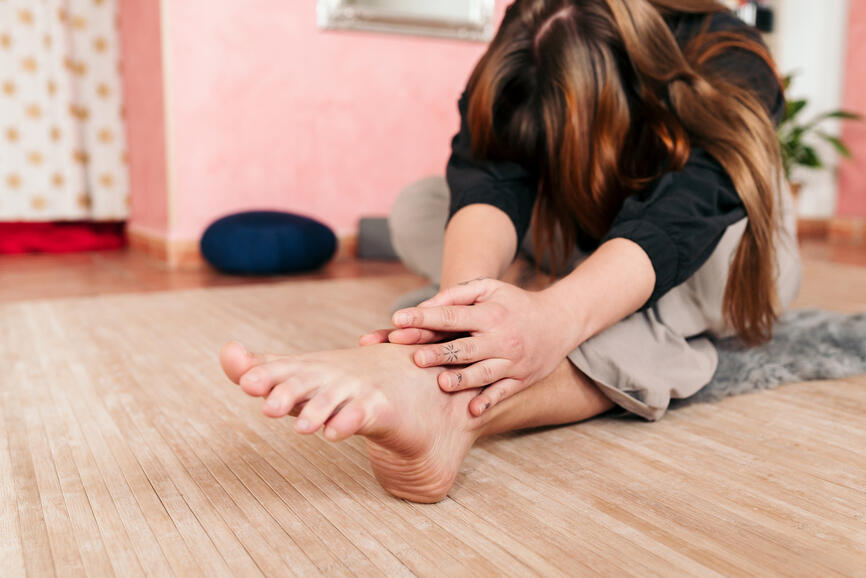6 Surprising Spots To Stretch on Your Body for Unexpected Relief

Glutes, hamstrings, and quads—these powerhouses make up the trifecta of muscles we tend to stretch before and after a workout. Whether it's prepping for a serious cardio session or recovering after a kick-ass HIIT workout, many folks tend to fixate on these three muscles, as well as other core body parts, like our back and hips.
But with roughly 650 different skeletal muscles in the human body, focusing on the "main" muscles, so to speak, leaves out hundreds of others just begging to be flexed—especially if you spend most of your day hunched over a computer. "Whether [you're working] remote or in-office, our bodies become vulnerable and oftentimes lead to poor posture," says Jorden Gold, founder of Stretch Zone. "It’s so important to focus on stretching these upper extremities, not just the lower back and hip flexors that frequently call our attention."
After you've rolled out your glutes and hammies, give your other muscles a break, too. Below are six other muscles to stretch for unexpected relief.
Feeling stiff? Here are 6 other muscle groups to stretch that feel surprisingly great
1. Your neck muscles
Gold says that, given the amount of time many of us spend sedentary straining over our laptops, our necks tend to get stressed in odd ways, leaving our muscles cramped and knotted. One way to loosen up your neck is through what he calls a "scalene stretch," which can be done in 15-30 second intervals.
"In order to relax your neck muscles, pull your head and neck to the opposite side of the pain-point, pulling your ear all the way down to your shoulder," Gold says. "This is an easy-to-perform stretch that can be performed from just about anywhere and will help relax your neck muscles."
That's not the only way to find relief in your neck.
2. Your chest and shoulders
Gold says there's more to working out your chest and shoulders than a bench press.
"Pec stretches are aplenty, ranging from an elbow-to-elbow grip behind the back, or clasping your hands behind your computer chair," Gold says. If you want to get those tough-to-reach anterior deltoids—your shoulder muscles—Gold recommends a raised backwards clasp. "Clasp your hands behind your lower back keeping your arms straight and raising them as much as possible while maintaining an upright posture." Hold for 15-30 seconds before releasing.
3. Your lats
Sitting all day in a desk chair can make our lats (or latissimus dorsi, if you're feeling fancy) get tight. These are the large, v-shaped muscles in our mid-back area that help stabilize our spine.
To loosen your lats, Gold suggests a riff on the classic Child's Pose from yoga. It doesn't even have to be face-down on a yoga mat: "Even standing up from your work-station and using the computer chair as support when stretching [forward] will help to relieve tension in your lats."
4. Your thumb muscles
TikTok, Instagram, Twitter—with so many social media platforms, it's hard to stop the scroll. Give stiff thumbs a break with a simple stretch developed by Danielle Weis, PT, physical therapist and orthopedic clinical specialist at Spring Forward Physical Therapy.
"All of the many devices at our literal fingertips are definitely predisposing young people to an increased risk for overuse or ‘repetitive strain’ injuries and future arthritis,” Weis previously told Well+Good. "The amount of time spent with the hands and wrists in angled, arched, or curled positions create a perfect storm for pain and overuse injuries.”
5. Your "uterus"
Okay, so you can't actually stretch your uterus. However, you can stretch the muscles around your pelvis, hips, and lower back which, for some people, get unbearably tight during their period.
Vanessa Chu, co-founder of the NYC-based studio Stretch*d, recommends a handful of localized exercises to help alleviate pain and discomfort. "Stretching will improve circulation to the region, reduce tension in these muscles and eventually, relieve pain. It also affects the parasympathetic nervous system, essentially telling your brain and body to relax," Chu previously told Well+Good. "The area is sensitive, so you want to give it space to open up and relax."
6. Your feet
Nike master trainer Traci Copeland previously told Well+Good that feet were one of the most overlooked body parts athletes forget to stretch. “Feet always get overlooked—we warmup everything else, but we don’t think about our feet enough,” she said. “But [stretching your feet] is great for injury prevention, and a great way to warm your body from the ground up.”
Some easy way treat your trotters? Copeland recommends walking on your tip-toes for just 30 seconds to get the blood moving. Or, do the opposite—rock back onto your heels and walk around on them, stretching your ankles and flexing your toes.
The post 6 Surprising Spots To Stretch on Your Body for Unexpected Relief appeared first on Well+Good

